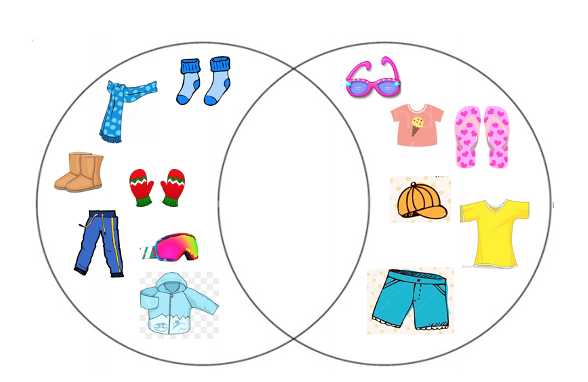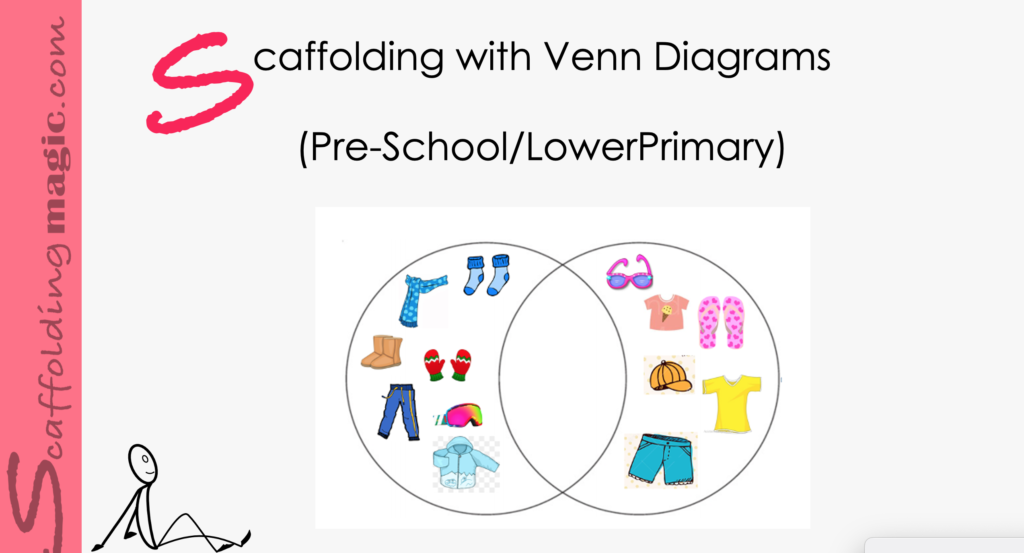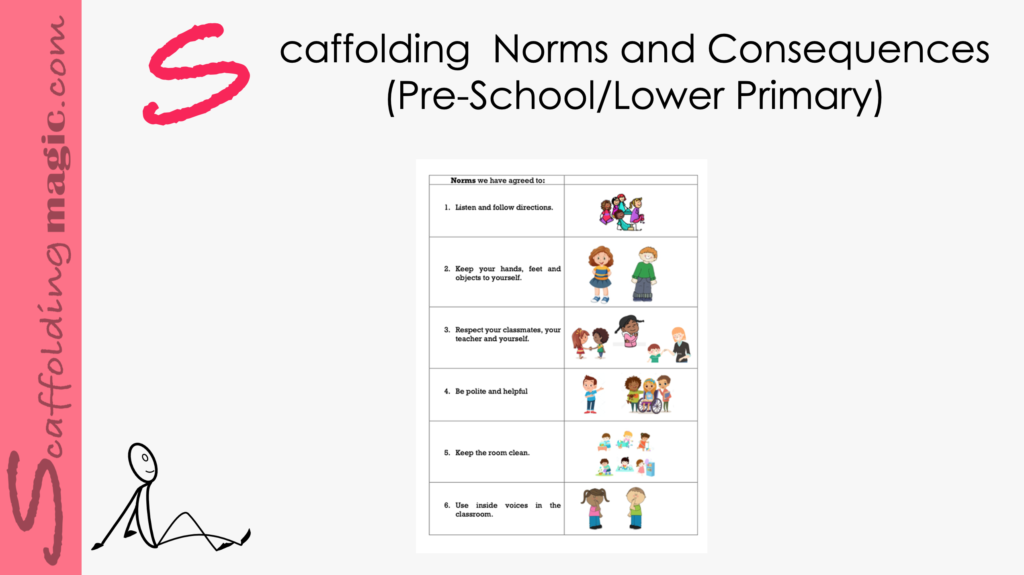You caught a beauty!!!
Download PDF of scaffold here.
Creating and using concept maps tends to have a high positive impact on student achievement.* Concept maps (graphic organisers) help students to see how various pieces of knowledge relate to one another. It helps structure their thinking. ** Venn diagrams are one type of graphic organiser that illustrate similarities, differences, and relationships between concepts, ideas, categories, or groups. This is the fundamental goal of scaffolding – to create activities for students that help them pull on past knowledge to move into new knowledge – and to become more independent learners.
Here we use information from a class on clothes, mixed with weather and parts of the body. Through interaction and dialogue***, students will discover the connection between clothes, parts of the body and weather. In this way, learning will go deeper and be more meaningful for them in the long term.
* (Hattie, 2012)
** (Mehisto, 2017)
*** You’ll see that we’ll need to give our students the academic language necessary to be able to talk about the concepts in the diagrams.
step by step
- Divide information from a unit you’re about to begin three ways in the 2-circle overlapping Venn Diagram. (Template here.)

- Project/show the academic language **** necessary for students to be able to speak about the information effectively, and make sure they understand the meanings. Work with the students to find the similarities and differences between the two categories of clothes, and connect them to weather and parts of the body.
Example: Bricks: summer, winter, spring, fall, shirt, pants, sandals, boots, etc..
Mortar: wears, on, under, around, same as, different, etc.
- Teacher: We see two circles and on the left circle we see clothes and on the right circle we see clothes also. Do you see any differences between the clothes in the two circles?
- Students: Some clothes are for winter and some clothes are for summer.
- Teacher: That’s correct. The clothes on the _________ circle are for winter.
- Students: LEFT!
- Teacher: Yes! And the clothes on the __________ circle are for summer.
- Students: RIGHT!
- Teacher: Yes, that’s correct. Now, which clothes so we wear on our feet?
- Students: Boots. Sandals.
- Teacher: Yes. We wear boots on our feet in the winter and sandals on our feet in the summer. Right?
- Students: Yes!
- Teacher: So, even though they look different, the similarity is that we wear them on our feet. So why don’t we write ‘feet’ in the middle so we know one similarity between the two categories.
- Students: Yes!
- Teacher: Now, which clothes do we wear on our legs?
- Etc.
- **** We use Jeff Zwiers’ concept of ‘bricks and mortar’ in identifying academic language, here. For more on this concept, you can read his article here.
Other Graphic Organisers to use in different scaffolds
- Formative Assessment:
Project/show clothes one by one and elicit descriptions and similarities and differences, also encourage them to mention weather and parts of the body.
- Reflection: Students talk to their partner and say what they felt about seeing the information so visually in the two circles.
**** We use Jeff Zwiers’ concept of ‘bricks and mortar’ in identifying academic language, here. For more on this concept, you can read his article here.
Education Place
The Cycle: Circular Flow Charts
Scholastic
* (Hattie, 2012)
** (Mehisto, 2017)
*** You’ll see that we’ll need to give our students the academic language necessary to be able to talk about the concepts in the diagrams.


Scaffoldingmagic.com is your entryway into DYNAMIC bilingual learning methodologies, such as Phenomenon-Based Learning, CLIL, EMI, and ESL. You’ll find ways to implement critical thinking tools (DOK) to promote higher level thinking, the growth mindset, instill an ethic of excellence, deep reflection on learning, and all through multi-cultural, interdisciplinary activities. We have the keys to turning competences into action and to creating collective efficacy in your school so you move ahead as a unified, enthusiastic team.




